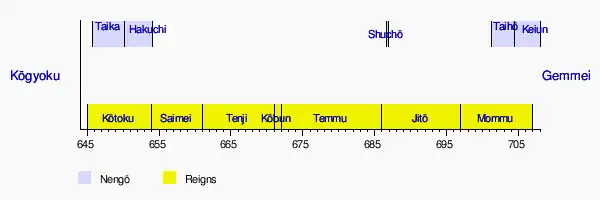Taihō (era)
Taihō (大宝) was a Japanese era name (年号,, nengō,, lit. "year name") after a late 7th century interruption in the sequence of nengō after Shuchō and before Keiun. This period started in March 701 and ended in May 704.[1] The reigning emperor was Mommu-tennō (文武天皇).[2]
History
The system of nengō mirrored the Chinese system of eras (nianhao).[3] The use of nengō marked a new phase in the history of the Imperial court. It became an example of growth in political power.[4]
Taihō was adopted to mark the discovery of gold in Tsushima.[5]
Timeline
| Timelines of early Japanese nengō and Imperial reign dates |
|---|
 |
The system of Japanese era names was not the same as Imperial reign dates.
Events of the Taihō era
- 701 (Taihō 1): Plans for mission to the Tang court was approved.[6]
- 702 (Taihō 2): The Taihō Code or "Code of Taihō" (大宝律令, Taihō-ritsuryō) or Taihōryō reorganized Japan's government.[7] It completed the Taika Reforms.[8]
- 701 (Taihō 2): A mission to the Tang court was led by Awata no Mahito (粟田真人). The diplomats travelled by ship.[6] This was called the "embassy of Taihō" because it was begun during this era.[9]
Related pages
References
- Nussbaum, Louis-Frédéric. (2005). "Taihō" in Japan Encyclopedia, p. 924.
- Nussbaum, "Mommu Tennō," p. 655; Titsingh, Isaac. (1834). Annales des empereurs du Japon, pp. 60-63; Brown, Delmer. (1979). Gukanshō, pp. 270-271; Varley, H. Paul. (1980). Jinnō Shōtōki. pp. 137-140.
- Nussbaum, "Taika" at p. 924.
- Bialock, David T. (2007). Eccentric Spaces, Hidden Histories: Narrative, Ritual, and Royal Authority from the Chronicles of Japan to the Tale of the Heike, pp. 56-57.
- Bender, Ross. (2009). "The Suppresion of the Tachibana Naramaro Conspiracy," Japanese Journal of Religious Studies 37/2:225; compare mirrored full-text Archived 2012-02-12 at the Wayback Machine; retrieved 2012-10-23.
- Fogel, Joshua A. (2009). Articulating the Sinosphere: Sino-Japanese Relations in Space and Time, pp. 102-107; publisher's blurb;
- Nussbaum, "Taihō ritsuryō" at p. 924.
- Asakawa, Kan'ichi. (1903). The Early Institutional Life of Japan, p. 13; Nussbaum, "Taika no kaishin" at p. 924.
- Ponsonby-Fane, Richard. (1962). Sovereign and Subject, p. 244.
Other websites
- National Diet Library, "The Japanese Calendar" -- historical overview plus illustrative images from library's collection
| Taihō | 1st | 2nd | 3rd | 4th |
| Gregorian | 701 | 702 | 703 | 704 |
| Preceded by: —— |
Era or nengō: Taihō |
Succeeded by: Keiun |
| Preceded by: Jitō period 686—697 |
Imperial reign: Mommu period 697—707 |
Succeeded by: —— |
This article is issued from Wikipedia. The text is licensed under Creative Commons - Attribution - Sharealike. Additional terms may apply for the media files.